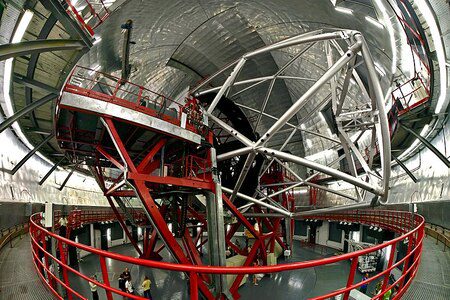Click here if you want to read this page in Spanish![]()
ELT telescope is one of ESO’s most prominent projects is the European Extremely Large Telescope: ELT (Extremely Large Telescope).
Beginnings of the ELT telescope
ESO has designed, financed and directed the construction and installation of the ELT, a proposal for a new generation of ground-based optical telescopes for the study of astronomy from Earth.
Since the end of 2005, ESO has been working together with more than 100 astronomers and astrophysicists from member countries to define the needs to be met by the new giant telescope.
In 2011, the governing bodies of the European Southern Observatory (ESO) approved its budget for 2012.

Some of the ELT’s optical components have already been designed. Among them a mirror 40 meters in diameter.
It will be the world’s largest optical-infrared telescope – the world’s largest eye to scan the skies.
The facility is expected to take 11 years to build and start work: 2014 to 2025.
One of the great unknowns was where this huge telescope would be located, which will have a 42-meter eye, and whose primary mirror will be made up of 984 hexagonal segments of 1.45 meters each.
Choice of ELT telescope site
In 2009, there were four candidate sites, but the favorites were two: the island of La Palma in the Canary Islands and the Atacama Desert in Chile.
Both candidates had compelling reasons for requesting to be awarded the election.
Finally, at the beginning of 2011, it was decided to install this extremely large telescope in Chile.

The budget included preparatory work to locate the Extremely Large Telescope (ELT), at Cerro Armazones, in Chile.
Cerro Armazones is in the north of Chile, in a privileged area for optical and infrared astronomy, as it has almost 350 clear nights a year.
ELT Features
The ELT has a modern and original design, will have a total height of 60 meters and will rest on a base of 100 meters.

It will be the largest optical telescope ever built. The performance, cost, schedule and risk have been evaluated with the utmost rigor. The cost is estimated at 1,000 million euros.
The ELT will be able to offer an amazing image quality, thanks to a set of powerful instruments equipped with the latest technology.
Objectives of the ELT
Its main task will be to investigate the origins and nature of galaxies, but it will also look for signs of life on planets located outside the solar system.
The additional modern devices that the ELT will have will facilitate detailed studies of various pending investigation issues:
- planets around other stars,
- primitive and very distant objects,
- supermassive black holes,
- the nature and distribution of dark matter and dark energy,
- the search for exoplanets and
- the study of the frontiers of physics:intense gravity, variations of fundamental constants, space-time structure.
The exoplanet Gliese 581
With the ELT, the discovery of planets orbiting near-Earth stars will progress significantly.
Even the difficult feat of finding and studying planets located in the habitable zone of their parent star could be accomplished.
Such could be the case of the planetary system detected around the red dwarf star Gliese 581.

The planet Gliese 581c has a radius 50% larger than that of the Earth and is located in the so-called habitable zone of its parent star, that is, where liquid water can exist.
It is known that it takes only 13 days to complete one orbit around its star.
The ELT will work in conjunction with ALMA
In connection with ALMA, the Great Set of Radio Telescopes in San Pedro de Atacama, the ELT will explore the darkest regions of the Universe.

Both telescopes will provide a wonderful insight into the history of the formation of galaxies and stars since the beginning of the Universe.
Distant galaxy clusters will also provide crucial information for understanding the origin and the early history of our Universe.
Both telescopes will also allow us to look back and study galaxies born just 500 million years after the origin of time and space.
The enormous photon collecting power of the ELT will make it possible to detect radial velocities in intergalactic gas clouds, illuminated by distant quasars.
With this information it will be possible to assess with great precision the cosmic acceleration of the Universe.



